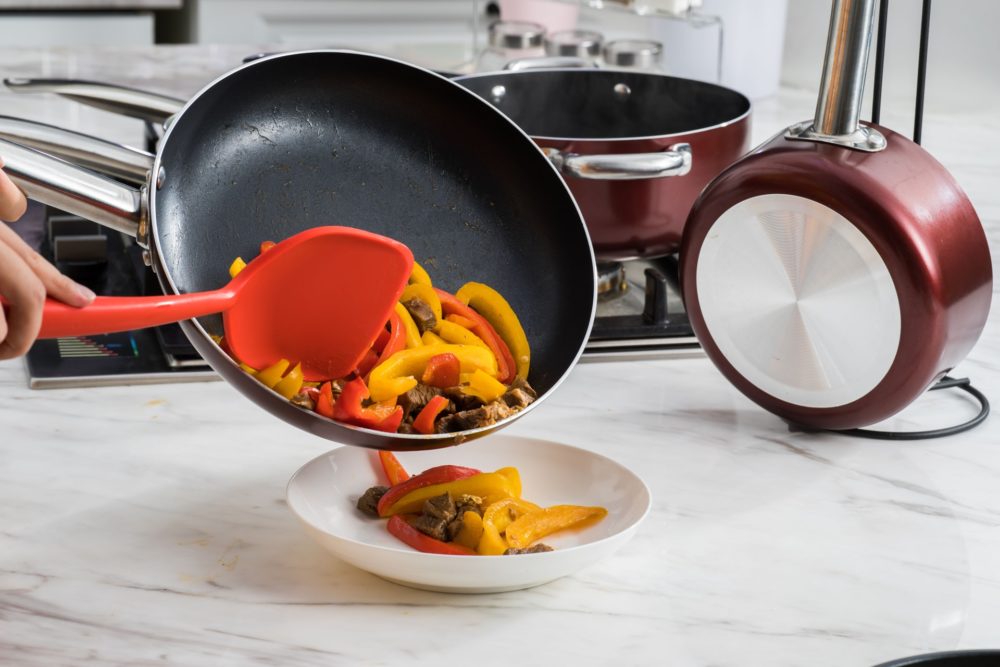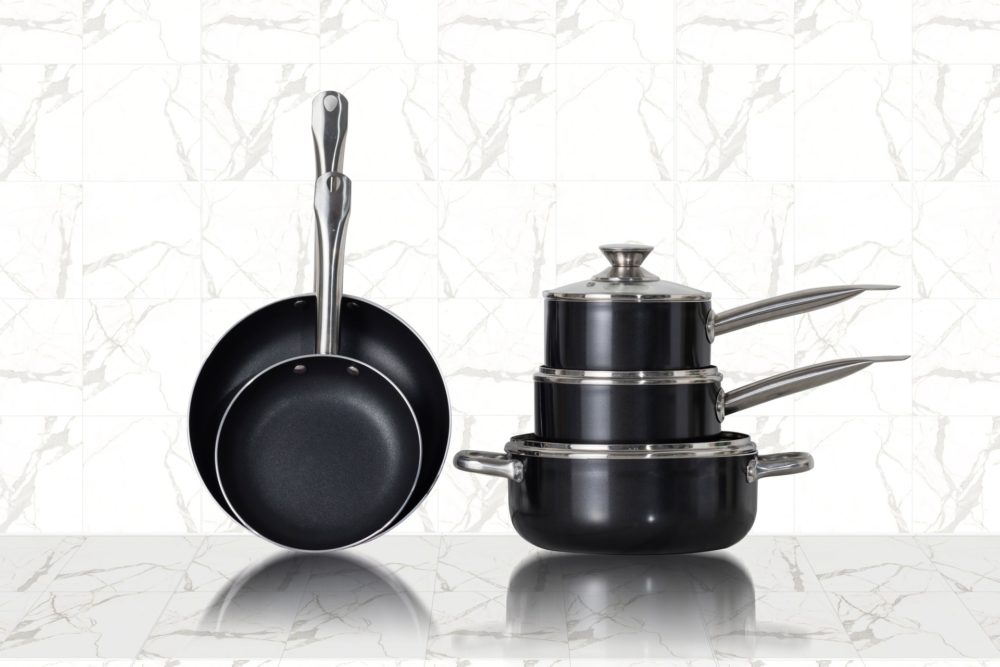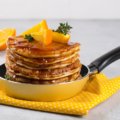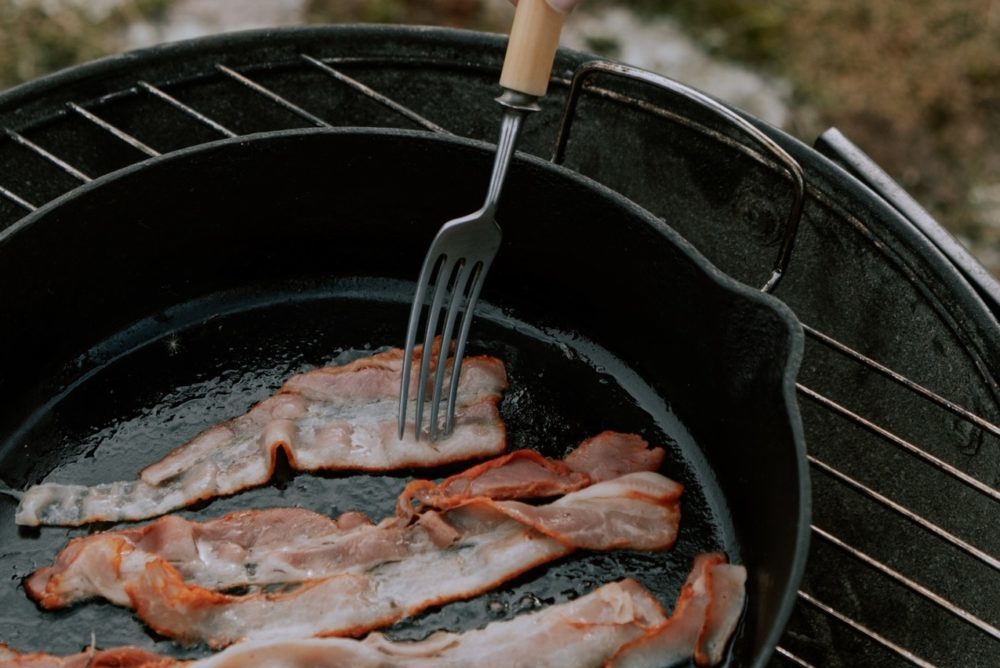In this day and age, a kitchen just isn’t complete without at least a couple of non-stick pans for some hassle-free cooking.
In fact, when you’re stuck using a pan without any special coatings, it makes you wonder how people even coped before they were invented. Before you know it, your egg’s an omelet, and then your omelet looks like it’s been passed through a shredder before it hits your plate.
There are such amazing non-stick pots and pans on the market now, there’s really no reason to suffer on without them, but does this slick coating come at a cost?
Teflon coated pans have become the subject of controversy in recent years due to their toxicity when overheated, but there are alternatives available.

We’ve put together a list of five of the very best nonstick pans without Teflon you can currently buy.
They work just as well, some may say better, and they’re safer to use.
After the reviews, it’s time to run through a quick buyer’s guide and FAQ section so you can see some of the things we considered when searching for our champion products.
Sick of prying your food from the pan with a crowbar?
Here’s our number one non-slip pick for a quick solution.
OUR TOP PICK
This slick champion is everything you could possibly want in a Teflon-free non-stick pan.
I’m sure you’ve heard that the cardinal sin of non-stick pan ownership is to use metal utensils, but don’t throw them in the trash just yet. The Le Creuset Pro has a surface strong enough to resist even the scratchiest of spatulas.
You’d think that a slightly textured surface would only give tricky foods and batters more traction on a pan, but the culinary wizards at Le Creuset disagree.
Not only does it resist adhesion, the texture actually speeds up the browning process, making it the best possible tool for searing those thick juicy steaks and crisp vegetables.
The proprietary triple-reinforced coating is safe at temperatures up to 500 degrees F on the stove or in the oven, and it’s perfectly capable of surviving the dishwasher, which means no tough cleaning jobs, yay!
So, the coating is on point, but what about general construction. I’m delighted to say, the good news just keeps on coming.
With an aluminum core and steel base, this pan is both strong and provides quick and even heat.
Ergonomic in shape, relieving hand and finger strain when dishing or washing up, the metal handle remains cool no matter how high intensive your burner is.
This thing is basically the Ferrari of frying pans. No longer will your pancakes end up panblobs. No longer will your bacon fuse eternally to the pan.
It’s not cheap, but if you’re looking for the best, you’ve found it.
Pros
- PTFE and PFOA free
- 3 levels of non-stick coating
- Compatible with metal utensils
- Dishwasher safe
- Textured surface is amazing for searing
- Aluminum core heats quickly and distributes heat evenly
- Steel base increases durability
- Handle is comfortable to hold and stays cool
Cons
- Mega pricey
EDITORS CHOICE
Green Life has honored its name by creating these amazing PFOA and PFAS-free pans.
Despite their easy-wash, wipe-clean surface, these pans are completely dishwasher safe, and what’s more, the interior is rivetless, preventing carbon from building up in the ridges.
Not only does the production process of their sand-derived coating create 60% fewer emissions than standard coatings, Green Life pans are made from recycled aluminum making them great for your food and the environment.
The handles are really special. Made from soft, heat-resistant material, they provide a comfortable and stable grip.
If you’re anything like me and have sensitive joints in your hand, you’ll really appreciate this feature, although it does mean you won’t be able to use these pans in the oven above 350 degrees Fahrenheit.
Not quite as strong as the invulnerable La Creuset champion, you’ll need to give these pans some extra care.
Always use a soft sponge, use wood or nylon utensils only, and under no circumstances should you use spray oils for lubrication.
All things considered, these are amazing pans, and we particularly love Green Life’s environmental ethos.
If you’re yearning to augment your culinary life, but refuse to do it at the expense of the planet, these are the ones for you, and they come in lots of beautiful colors too!
Pros
- Soft-grip ergonomic handles
- Coating production produces 60% less CO2 emissions than competitors
- Aluminum core for quick and even heat
- Non-wobble base
- Amazing price
- PFAS, and PFOA free
- Comes as a set of two
- Rivetless interior
Cons
- Can’t use metal utensils
BEST VALUE
Third on this rather slippery list, we have a top-quality Teflon-free pan from Switzerland.
They look like they’re made from granite, but don’t worry, you’re not in the Flintstones, neither is it some mad science gone too far or full-blown witchcraft. The granite effect is made using sand, just like other ceramic coatings.
What’s amazing about this pan is the layering process. There are five in total including ceramic primers and polymer matrixes making the surface as durable as it is slippy.
If you could peer underneath those many coats, you’d discover a core of solid die-cast aluminum which is tough, non-reactive, and an excellent conductor of heat.
The wood-finish handle stays cool on the hob, but can only cope with oven temperatures up to 350 degrees F.
Of all the amazing pans on this list, this is the most popular, which speaks volumes.
It’s dishwasher safe, fairly durable, cooks exceedingly well, is surprisingly inexpensive, and if by some minute chance you’re not completely happy with it, it has a 12-month warranty too.
Pros
- Layered ceramic coating
- Cool granite-style finish
- Very affordable
- Most popular pan on the list
- Die-cast aluminum core
- Comfortable heat-resistant handle
- PFOA-free
- Comes with extended warranty
- Dishwasher safe
- Rivetless interior
Cons
- Plastic handle reduces oven temp capacity
RUNNER UP
The penultimate pans are a force to be reckoned with.
Coated with healthy Thermolon ceramics reinforced with diamonds, you’re free to use any kind of utensil with no risk of compromising the surface.
Yep, metal utensils are fine in this case, but this pan is so slick, you may need no utensils at all. Simply slide the food straight from pan to plate.
The strength of the coating also means that you can safely stack these pans, which you’re normally told to avoid, so If storage real estate is finite in your kitchen, you could tuck them discreetly away in a corner.
Beneath the diamond-infused ceramic coatings, you have a duo-forged die-cast aluminum core perfect for quick, even cooking.
Using what’s known as a magneto induction base that makes as much contact with a stove as possible, Green Pan has created an incredibly responsive tool, perfect for use on electric tops.
Green Pan doesn’t just want you to be safe from toxins, they’ve also put a lot of thought into keeping your hands safe.
The extended V connecting the handle to the pan acts as a flame guard, keeping your hand a safe distance away, and it’s safe for oven use so long as the temperature doesn’t exceed 320 degrees F.
They’re a little pricer than others, but we can’t dispute their quality.
Pros
- Made with healthy ceramic coatings
- Coating is resilient enough to handle metal utensils
- Dishwasher safe
- Stackable
- Magneto induction base is great for electric and induction stoves
- PFAS and PFAO-free
- Duo-forged die-cast aluminum core
- Flame guard stay-cool handle
Cons
- Pricey
- Only oven-safe below 320 degrees F
RUNNER UP
The last pan on our list also uses a compound of diamond and ceramic to attain the non-stick surface, although it’s important to note that it’s not quite as slick as the pans on the list and will require some sort of lubricant.
As far as scratch resistance goes, it’s about as strong as they come. Even if you’re guilty of sometimes brandishing a fork for flipping burgers or turning sausages, this pan’s coating will hold strong.
Still, to keep the coating in top shape, I’d recommend avoiding metal utensils.
Marketing doesn’t draw much attention to Blue Diamond’s core. We assumed it was aluminum due to its weight, did some digging, and found out we were right, which also explains its speedy heating duration.
What this pan has that the others are lacking (except our top pick), is a full metal handle which means it’s capable of surviving temperatures up to 850 degrees C on the stovetop and in the oven itself.
Oven-friendly pans are amazing for giving curries a final bake to maximize flavor and thicken the sauce, for large cuts of meat that need to be seared and roasted, for fish, vegetables...you name it.
Pros
- Scratch-resistant
- Diamond-strewn ceramic coating
- Toxin-free
- Dishwasher safe
- Oven safe up to temperatures of 850 degrees F
- Aluminum core
- Affordable
- PFOA-free
Cons
- Non-stick coating isn’t as effective as other pans on the list
- Blue Diamond has been accused of exaggerating this pan’s abilities
Best Non-Stick Pan Without Teflon Buying Guide
Buying pans used to be a simple process. Choose the metal that suited your cooking style and you were sorted.
Now, with them coated in this and that and reinforced by complex scientific processes and new-fangled materials, who knows what you’re getting yourself into.
That’s why we’ve composed this little buyer’s guide to help you in what can be a truly headache-inducing task.
Budget
A quality Teflon-free non-stick pan can cost anywhere between $15 and $200, so you don’t need to break the bank to kit out your kitchen, but if you want top-quality, prepare to spend some serious cash.
What Are Your Options?
It’s easy to get lost in scientific lingo and end up thinking there are multiple substances that give pans that magical slippy quality, but apart from a few variations in their application, your options are always either Teflon or ceramic.
What Actually is Ceramic?
Ceramic coatings are produced using sand. It’s a glazing process, but ultimately, it’s not the ceramic that gives your pan that otherworldly non-stick ability.
The ceramic layer is then further coated with an outside gel glaze that impregnates any gap or imperfection in the surface.
PTFE and Other Confusing Abbreviations
There’s no way around it. When shopping for a pan, you’re going to run into plenty of nonsensical jargon.
Brands use them as buzzwords for selling their products but normally they raise more questions than they answer.
So, in the spirit of clarity, here are a few esoteric abbreviations explained in plain English.
PTFE
PTFE is polytetrafluoroethylene - try saying that quickly after a few whiskeys.
It sounds complicated because it is complicated, but luckily for you, all you need to know is that if you’re avoiding Teflon, avoid anything described as using PTFE as a coating.
PTFE is Teflon. Teflon is PTFE. Teflon is simply a branded name for the substance.
PFOA
An abbreviation of perfluorooctanoic acid, PFOA is commonly used for waterproofing materials and creating Teflon non-stick cookware coatings.
It’s widely thought to be a carcinogen. Alternative non-stick coatings don’t use PFOA, but it’s always good to make sure a pan explicitly states that it’s PFOA-free before buying.
PFAS
PFAS stands for polyfluoroalkyl substances. This is a blanket term for a collection of manmade chemicals, PFOA being one of them.
They’re all known to cause adverse health effects in animals and humans.
A healthy pan may not state that it’s PFAS-free, but as long as it clearly claims to be PFOA free, you’ve got nothing to worry about.
Lead and Cadmium
You also need to keep an eye out for pans that may have trace amounts of lead or cadmium in their coatings.
They can leach out into your food, possibly causing neurological, organ, and bone damage.
The good news is that if a company has gone to the trouble of making a pan PFOA-free, it’s likely to be lead and cadmium free too.
Materials
Core
As you’ve probably guessed from the list, die-cast aluminum is one of the best core metals for pans. It’s lightweight, durable, and it conducts heat quickly and evenly. Aluminum strategically reinforced with steel is even stronger.
Cast iron pans don’t often come with any special coatings, but they do have light natural non-stick qualities.
If you season them properly and consistently, they’ll be just as slick-surfaced as a fancy ceramic or Teflon pan.
That said, cast iron rusts really quickly. To avoid oxidization, you’ll need to wash them with kosher salt and soapless water.
Stainless steel is incredibly strong, but it’s also quite heavy and a poor conductor of heat. Along with cast iron pans, they’re favored for searing and browning food.
Non-stick steel pans aren’t as common as aluminum pans because they’re natural sticky quality is helpful for cooking tasty marinades and sauces.
The French call the bits that stick, fonds. Before they burn, they’re full of flavor, so dislodging them and stirring them into the sauce actually makes it tastier.
Temperature
We’d recommend looking for a non-stick pan with the highest safe temperature possible.
Let’s face it, we never really know how hot our pans are on the hob, so how are we to know if we’re exceeding the max temp.
A pan with a high heat capacity will prevent accidental overheating.
Handle
Plastic handles can actually be marvelous for giving you a comfortable and cool grip on your pan, but if you want to be able to shove that pan in the oven, you need to look for a quality metal handle.
If you’re more of a comfort seeker than a culinary thrillseeker, soft-touch handles are easy on the hands and joints.
Frequently Asked Questions
Can you use metal utensils with ceramic pans?
Some are so well designed that they can resist damage from metal utensils for a while, but if you want to make any non-stick pan last longer, use nylon or wooden utensils.
What pans do not have Teflon?
Any pan described as ceramic shouldn’t contain Teflon, but to make sure, check it claims to be PTFE, PFOA, or PFAS-free.
Should I throw out my Teflon pans?
No, as long as you use them responsibly, they won’t cause any harm.
They only release toxic gasses if they’re pushed beyond 570 degrees Fahrenheit.
Should you season non-stick pans?
Yes, it’s a great idea to season non-stick pans. It gives them an extra layer of protection, helping them to last much longer.
You can also season them after the non-stick coating has worn away to replenish some slipperiness.
Are all non-stick pans toxic?
No, some are non-toxic. The ones on this list for example are technically safe-use pans.
That said, you should always follow the temperature guidance provided by the manufacturer if you want your non-stick coating to last.
Summing Up
There you have it, folks: five of the best non-stick pans without Teflon, and an illuminative buyer’s guide and FAQ section to see you on your way.
Shopping for pans can be confusing and infuriating, but as long as you remember what shouldn’t be in them, the process becomes a lot easier.
Ask yourself if it’s ceramic or PTFE/Teflon. Ask yourself if it’s PFOA or PFAS-free. Does it advertise the fact that it’s non-toxic? Is it free from lead and cadmium?
Keep asking questions and you’ll have a sweet collection of safe pans in no time.














